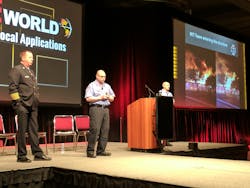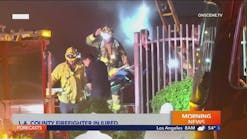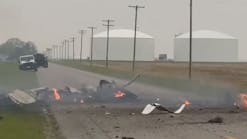FHWorld17: Lessons Learned from Knights of Columbus Hall Fire
“The fire service has to change.” These words from Bryan, TX, Fire Department Fire Chief Randy McGregor while sharing the story of the Knights of Columbus Hall fire, which claimed the lives of lieutenants Eric Wallace and Greg Pickard and severely burned Firefighter/Paramedic Mitch Moran and Firefighter Ricky Mantey on Feb. 15, 2013.
Moran and Mantey joined McGregor during a Tuesday Firehouse World session covering the lessons learned from the tragic fire. The three walked through the events of the tragic incident, offered lessons learned and shared the changes that the department has since implemented. The three men underscored that firefighters can’t look past line-of-duty deaths from other departments and think it can’t happen to them.
Incident summary and lessons
Bryan Fire Department (BFD) crews responded to a fire at the Knights of Columbus Hall, and the first-in crews initiated interior fire suppression operations. Mantey shared that when they first arrived on scene, it seemed like a routine operation and they would take care of it and get back to bed. Moran noted that there was light, lazy smoke—nothing out of the ordinary.
Wallace and his crew entered the structure, and at some point during their operations, Wallace became separated and radioed for help. With fire conditions deteriorating, an evacuation order was called. McGregor emphasized that this just shows how quickly conditions can change. “Everyone’s rolling in doing their jobs, then in a matter of minutes we’re in crisis mode,” he said.
McGregor noted that Wallace never actually transmitted a mayday, which created some confusion on the fireground. He emphasized the importance of calling a mayday when in trouble to help other crews know how to proceed.
Pickard, Moran and Mantey were assigned to the rapid-intervention team (RIT). Mantey acknowledged that crews often don’t like being on the RIT, but when it matters, you have to be prepared. “Always have open ears and an open mind when you’re on RIT so you know what you need to do when you need to do it.”
RIT entered the structure to rescue Wallace. “It was the darkest and blackest smoke you have ever seen in your life,” Mantey said. “You couldn’t see an inch in front of you. I never want to be in that situation again.” Fortunately, when calling for help, Wallace had identified that he was on the red hoseline (there was also a yellow one in the structure), which helped the RIT locate him. “[If in this situation,] make a note of the color because if you get lost, you can say where you are,” Mantey said.
Mantey described seeing “shooting stars” passing him as he made his way to Wallace. “Signs of flashover,” he realized later. “But we had a job to do, so we kept going, trying to find Lt. Wallace.”
After about 2 minutes, the team located Wallace approximately 40–50 feet inside the structure. At this point, Mantey made sure to tuck the red hoseline under his armpit so he wouldn’t become separated from it, as it was their lifeline to find their way out of the building. With the hoseline under one arm, he used the other arm to help carry Wallace toward the exit.
Approximately 10 feet from the hall’s foyer—the crew’s “safe zone,” flashover occurred, engulfing the men in flames. McGregor said the team never relented in trying to drag Wallace out of the building, underscoring how proud he is of their efforts to save their fallen brother. Additional crews were able to rescue the RIT and Wallace one by one, and extinguish the burning turnouts.
McGregor described the situation immediately following their removal, recalling Moran saying to him, “Chief, I love you.” He does this incredible act of heroism and now this young man thought he was about to die,” McGregor said.
Wallace, Pickard, Moran and Mantey were transported to the hospital, where Wallace was pronounced dead. The others were airlifted to Blocker Burn Center at UTMB Galveston. Pickard succumb to his injuries the following day. Moran and Mantey suffered burns to approximately 50 percent of their bodies.
McGregor said that when something like this happens, you have to simultaneously manage the tragedy of the loss but still provide the care and support to the injured firefighters and their families. He said having LODD packets was helpful in coordinating the necessary communication during such a chaotic time.
McGregor, Mantey and Moran all lauded the amazing support system, including the crewmembers, hospital staff, families, the city itself, and other department personnel, particularly the city of Galveston, for the assistance provided during such a difficult time. “I pray you never have to go through this,” McGregor said. “But if you do, you’ve got to accept help. You have no choice.”
Moran and Mantey have since had more than a dozen surgeries each. Mantey emphasized that it is his mission to not let any firefighter go through the same pain and misery, which is why they share their story.
Department changes
Following the incident, the department had a choice, McGregor said, “Are we going to call this bad luck and stick our heads in the sand or are we going to do something about it?” The answer was clear: They had to do everything possible to prevent it from happening again. “Part of that is being here today,” he added.
With that in mind, McGregor then outlined the numerous changes the BFD has implemented. It started with forming an operations committee, which consisted of personnel from all ranks. The committee’s primary responsibility was to thoroughly review all firefighter and operational SOPs to determine any changes needed to increase the level of safety of BFD personnel while operating at structure fires.
Following are some of the changes implemented, points of interest about the fire and lessons learned:
Staffing Increase and Resolution
- June 25, 2013, the Bryan City Council unanimously passed a staffing resolution that proposes adding personnel over a 10-year period to raise the minimum staffing on all fire apparatus to four firefighters.
- Full-time assigned chief’s aide added.
- Additional fire inspector position added to fire marshal’s office.
Increase of Staffing on Initial Response to a Structure Fire
- Another engine company was added to the initial alarm to provide for specific needs.
- The “blocking line” will deploy alongside the RIT solely to provide protection from heat or flashover while the RIT is locating and extracting the downed firefighter.
- Apparatus operator of the fourth engine will immediately report to the IC and serve in the role of the chief’s aide and scribe.
Implementation of Mayday Mode of Operation
- During a mayday mode, the EMS supervisor who typically serves as incident safety officer will report to Command as the rescue group officer when mayday mode is declared by Command. Command will assign someone else to the safety officer position.
- Trapped/lost firefighter(s) and the company members with them will remain on the assigned radio talk group as will the RIT and the blocking line crew monitored by the rescue group officer.
- All other companies engaged in firefighting operations will move to a pre-determined tactical channel (Tact 6) to communicate firefighting operations.
- When a mayday mode is confirmed and declared by Command, RIT and the blocking line will deploy to begin rescue operations.
Coordinated Hose Line Rotations Providing Relief for Attack Crew and Reducing Firefighter Fatigue
- Crews who have been actively involved in firefighting will come out when necessary and report to rehab.
- After rehab, the crew that was previously assigned to the blocking line will now engage in the remaining firefighting tasks.
- The blocking line will remain in place as long as the RIT is standing by.
Thermal Imaging Camera Use
- During the Knights of Columbus fire, it was noted that not all company officers had a TIC with them during firefighting efforts.
- Prior to the fire, the use of TICs was encouraged and expected but not addressed as mandatory in SOPs.
Hoselines
- Previously, all engine companies carried two 150-foot hoselines midsection of the truck (one red, one yellow) and two 200-foot hoselines on the rear of the truck (one red, one yellow).
- Different color hoselines used to distinguish between each other in the event a firefighter had to follow a hoseline out of a building.
- All pre-connected hoselines will be 200 feet in length.
- Company officers are now required to announce what color hose they are on when entering the building.
Communications
- During the rescue operation of Lt. Wallace, it was very difficult at times to communicate due to the number of personnel on scene and the intensity of radio traffic during the rescue.
- The IC had to manage both efforts while monitoring all radio communications.
- Communication changes include separating radio talk groups when a mayday situation is declared, establishing a designated Rescue Group Officer to monitor rescue operations.
- Reprogramming portable radios to have voice-announced talk groups.
- Last talk group on the radio dial is now also programmed to Tact 6 so if any confusion remains as to which talk group is which, the radio operator can roll the talk group selection clockwise until it stops and they will be on Tact 6 as well.
Upgrades to PPE
- BFD has been specifying and purchasing high-quality firefighting coast and pants for years.
- The gear worn during the fire sustained heavy damage; it is believed to have performed well.
- After the fire, another layer of Quantum 3D SL2i was added to the complete thermal cape of the coat.
- PPE committee research firefighting hoods that are currently available to determine if a higher level of protection is available.
- The committee recommended a four-layer hood with a steam-resisting layer.
- The department replaced all hoods with the hood the PPE committee recommended.
- Replaced all SCBA masks to the new high-temperature masks.
Air Supply
- All 30-minute SCBA cylinders have been replaced with 45-minute cylinders for additional air supply.
Identification of Probationary Firefighters
- In order to better recognize probationary firefighters at fire scenes, the tetrahedrons on a probationary firefighter’s helmet and the leather helmet front are now green.
Final thoughts
McGregor noted that prior to this fire, he thought of the word “aggressive” in a different way; now it’s not as good. He acknowledges that the more aggressive mentality goes with the ego side of the job. “We realized we can’t do that anymore; it doesn’t make sense,” he said. “A lot of the things we do are incredibly stupid. We’ve got to embrace the new science and technologies.” He said this has been tough for some members, but when you see the suffering, it’s easy to question what those buildings are worth in comparison. “There’s nothing worse than going through this,” he said.
Moran returned to full duty on Feb. 15, 2014, the one-year anniversary of the fire. Mantey returned to administrative work in May 2015.

Janelle Foskett
Janelle Foskett served as editorial director of Firehouse Magazine and Firehouse.com, overseeing the editorial operations for the print edition along with working closely with the Web team.






